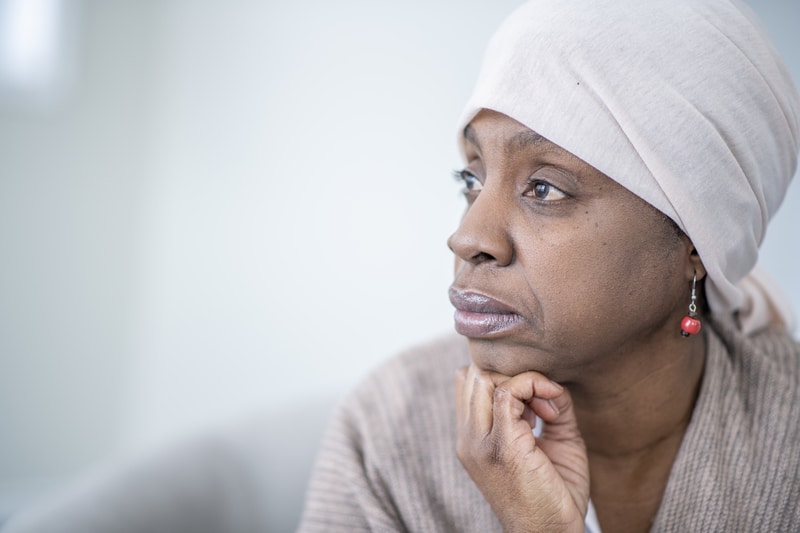Health disparities in the African American community remain a major issue. As a group, blacks have the shortest survival and highest death rate of any ethnic group in the United States for most cancers. These cancer disparities are complex, as they reflect economic and social inequalities and cultural differences. A lack of access to high-quality cancer care is another reason for these disparities in the black community.
The Risk of Developing Cancer
The chance of being diagnosed with any cancer increases with age, as the majority of cancers take years to develop. Approximately 1 in 3 African Americans will be diagnosed with cancer, and 1 in 5 will die from the disease. Prostate cancer in African American men is the most common diagnosis, while lung and colorectum cancer rank second and third. On the other hand, breast cancer in African American women ranks first, followed by lung and colorectum cancer. These four types of cancers account for over half of all cancer cases in the black community.
Cancer Disparities Between Blacks and Whites
Incidence and death rates are higher for black men compared to white men for all types of cancers. However, black women have a 7% lower cancer diagnosis than white women but a higher risk of death (13%). For example, black women have a 41% higher death rate for breast cancer and a 98% higher death for uterine corpus cancers than white women. Incidence rates for myeloma, stomach cancer, and Kaposi sarcoma range between 2-4 times higher in blacks than whites.
Risk Factors for Cancer
Researchers from the American Cancer Society estimates that around 42% of all cancer cases and 45% of cancer-related deaths for people of all races could be connected to modifiable risk factors. These risk factors include alcohol intake, cigarette smoking, excess body weight, sedentary lifestyle, exposure to cancer-related infectious agents, and poor nutrition. Knowing these various risk factors is essential in better understanding African American health issues.
Here is an overview of the various risk factors that can result in cancer disparities for the black community.
Tobacco
The use of tobacco is the most preventable cause of death in the United States. Research shows that cigarette smoking increases the risk of at least 12 different cancers. Smoking cigarettes may also increase the risk of prostate cancer in African American men. Historically, smoking is higher in black men than in whites, which creates significant health concerns. The popularity of e-cigarettes with students is also a significant cancer risk, and the long-term effects of using these products remain unknown.
Excess Body Weight and Not Enough Exercise
Knowing how to maintain healthy body weight is a struggle for many people. Following nutrition and physical activity guidelines can help reduce excess body weight and minimize cancer care. The prevalence of obesity throughout the United States has dramatically increased in all races in the past four decades. Limiting alcohol consumption, engaging in frequent physical activity, and keeping track of your daily calories help you lose weight.
Alcohol Consumption
Approximately 6% of cancer cases occur due to alcohol consumption. Drinking three or more alcoholic drinks each day may increase the risk of suffering pancreatic or stomach cancer. The combination of using alcohol and tobacco further increases the risk of cancer. According to statistics, alcohol use is much lower in black adults compared to whites.
Breast Cancer in African American Women
Detecting cancer early is essential in reducing deaths. It’s recommended that black women over 50 should schedule annual mammography at least every two years. Identifying cancer at an early stage is critical to successful breast cancer treatment. Statistics show that black women are 40% more likely than white women to die of breast cancer, and this number rises to 50% for black women over 50. Receiving early breast cancer treatment is the best way to reduce these numbers.
Cervical Cancer Screening Process
Cervical cancer screening every three years is also essential for women between the ages of 21-29. Women vaccinated against HPV should still be screened, as the vaccine doesn’t offer any protection against all types of HPV or established infections. Pap testing is recommended every five years for women between the ages of 30-65. After 65, women should discontinue screening if they had a recent Pap test.
Lung Cancer Screening Process
Annual lung cancer screening is always recommended for adults between 55 to 74 who currently smoke or quit smoking within the last 15 years. Cessation counseling and medication are often recommended for current smokers due to the high risk of needing cancer treatment in the future. Staying proactive by quitting smoking can play a crucial role in avoiding the need for cancer treatment.
Prostate Cancer in African American Men
There is no formal recommendation for prostate cancer screening because of the risk of severe side effects. However, the risk of prostate cancer in African American men is higher than in other races, as it’s important to know the risks and benefits of prostate cancer screening at age 45 or higher. The death rate of prostate cancer in African American men is more than double those of any other race. Receiving early prostate cancer treatment is crucial to improving these rates.
Factors that Influence African American Health Disparities
Several factors impact risk factors in the black community. For example, 21% of blacks lived below the poverty line in 2017 compared to only 9% of whites. Anyone of low socioeconomic status is also more likely to engage in risky behaviors that will increase cancer risk due to various marketing strategies focusing on these populations. The chance of needing cancer treatment will often increase as socioeconomic status decreases. Access to quality health care also influences African American health disparities. People with no health insurance are more likely to be diagnosed with an advanced form of cancer compared to someone that’s privately insured.
How the American Cancer Society is Reducing Cancer Disparities for African Americans
The American Cancer Society (ACS) uses a variety of methods to reduce African American health issues. Currently, the ACS is providing funding for 59 research grants focused on these health disparities by looking at ways to understand better why they exist and how to overcome these challenges in the black community.
ACS is also working with leaders in the community to pilot health equity projects. The NFL is also helping to support ACS by providing two-year grants for health systems across 32 cities in assisting women to receive better access to breast cancer screening and timely follow-ups for mammograms without the need for insurance.
The ACS is working with Pfizer to decrease the breast cancer mortality disparity among black and white women. This partnership is also looking at ways to reduce disparities for black men facing prostate cancer treatment while minimizing systemic barriers to ensure the black community receives the best possible cancer care.
Closing Thoughts
Health disparities in the African American community pose significant challenges but looking at ways to overcome these issues is critical in providing equal cancer care, such as prostate cancer treatment and breast cancer treatment. Bringing greater awareness to this problem while working with various groups can help minimize these cancer disparities and play a key role in improving the overall health of the African American community.

